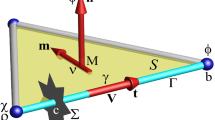Summary
For a particle in Stokes flow the relation between the expansion tensors appearing in the perturbation velocity to gradients of the undisturbed (though arbitrary) velocity are called Faxén relations. The expansion tensors themselves turn out to be defined in terms of moments of the stress and velocity distribution, evaluated for any surface completely enclosing the particles. Since these moments vanish if the stress and velocity fields are regular inside the particle the Faxén relations can be used advantageously, if the classical method of reflections for the hydrodynamic interaction between two particles applies, i.e. if the particles are sufficiently far apart. Assuming this to be so for two interacting spheres, a general recursion formula for the expansion tensors of the (j+1)st reflection in terms of expansion tensors of thejth reflection is derived via the Faxén relations. In this way the interaction problem is reduced to a bookkeeping one. This is demonstrated by calculating the friction tensors to the fourth power of the inverse interparticle distance. Furthermore by evaluating the stresslet for a suspension of pair-interacting spheres we obtain an estimate of the suspension viscosity up to quadratic terms in the volume fraction.
Zusammenfassung
Für ein Teilchen in schleichender Strömung werden die Beziehungen zwischen den Entwicklungstensoren der Störgeschwindigkeit zu den Gradienten des ungestörten (aber beliebigen) Geschwindigkeitsfeldes Faxén Relationen genannt. Die Entwicklungstensoren selbst ergeben sich als Momente der Spannungs- und Geschwindigkeitsverteilung, berechnet über irgendeine beliebige Oberfläche, die das Teilchen umschließt. Da diese Momente für jedes Geschwindigkeits- und Spannungsfeld verschwinden, das im Innern des Teilchens regulär ist, können die Faxén Relationen vorteilhaft angewendet werden, wann immer die Reflexions-methode für 2 Teilchen gültig ist, d.h. die Teilchen müssen genügend weit voneinander entfernt sein. Mit Hilfe der Faxén Relationen wird für wechselwirkende Kugeln im letztgenannten Fall eine Rekursionsformel für die Entwicklungstensoren der (j+1)ten Reflexion abgeleitet, die nur von den Entwicklungstensoren derjten Reflexion abhängt. Dadurch braucht man bei dem hydrodynamischen Wechselwirkungsproblem nur noch genau Buch zu führen. Dies wird dadurch demonstriert, daß die Reibungstensoren bis zur vierten Potenz des inversen Kugelabstandes berechnet werden. Indem wir auch das Stresslet in einer Suspension paarweise wechselwirkender Kugeln berechnen, erhalten wir eine Abschätzung der Suspensionsviskosität einschließlich Gliedern quadratisch in der Konzentration.
Similar content being viewed by others
References
H. Lamb,Hydrodynamics, Dover Publ., New York (1932).
J. M. Rallison, J. Fluid Mech.88, 529 (1978).
G. K. Batchelor, J. Fluid Mech.41, 545 (1970).
P. Brunn, Rheol. Acta.15, 104 (1976).
J. Happel andH. Brenner,Low Reynolds Number Hydrodynamics, Noordhoff Int. Publ., Groningen (1973).
P. Brunn, Rheol. Acta.18, 229 (1979).
H. Brenner, Chem. Engng. Sci.19, 599 (1964).
B. V. Felderhoff, Physica,89A, 373 (1977).
D. Bedeaux, R. Kapral andP. Mazur, Physica,88A, 88 (1977).
Author information
Authors and Affiliations
Rights and permissions
About this article
Cite this article
Brunn, P. Faxén relations of arbitrary order and their application. Journal of Applied Mathematics and Physics (ZAMP) 31, 332–343 (1980). https://doi.org/10.1007/BF01590660
Received:
Revised:
Issue Date:
DOI: https://doi.org/10.1007/BF01590660



